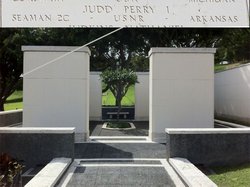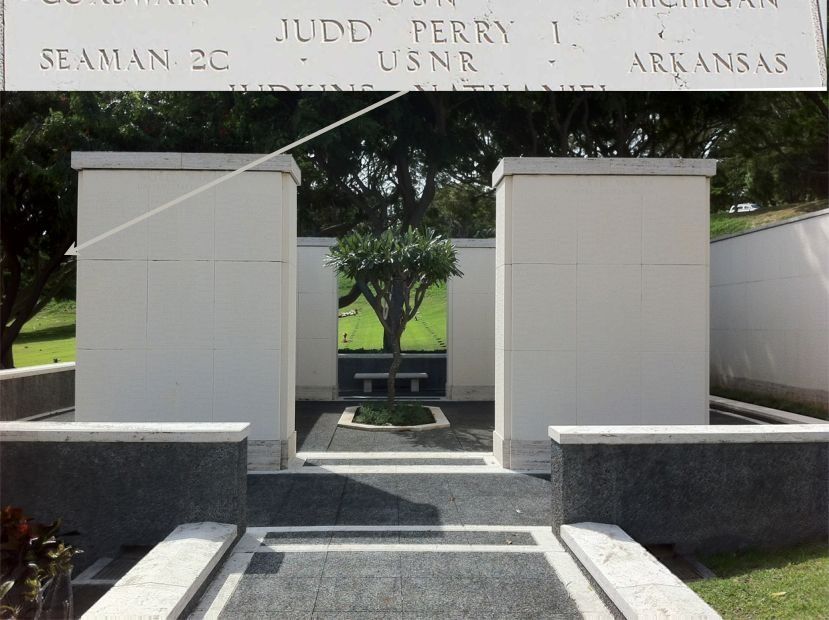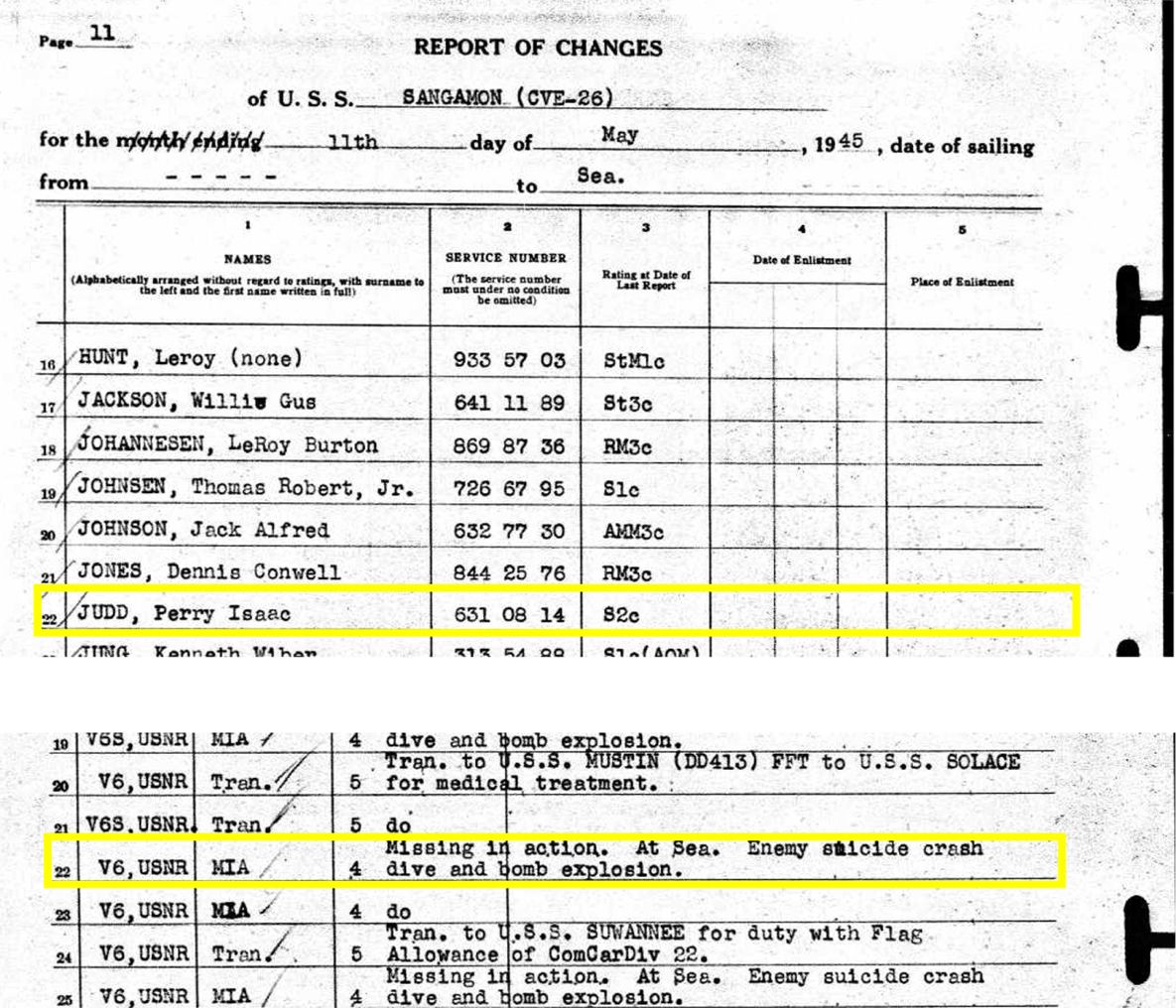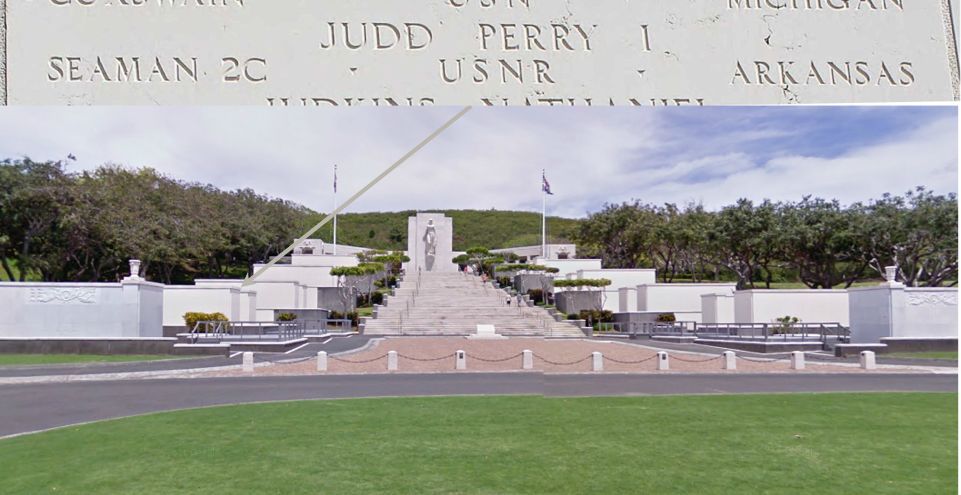Service # 6310814
Date of Enlistment: 4 June 1943
Duty: U.S.S. Sangamon CVE-26, Aircraft Carrier
Date first received on board: 18 Sep 1943
Status: Missing 4 May 1945 at the Battle of Okinawa
Next of Kin: Mr & Mrs (Effie) Perry J Judd, Helana AR
U.S. Awards: Purple Heart Medal
It all started on May 4, 1945 at the Battle of Okinawa. Late that day, at about 7 p.m., a Japanese suicide plane, also known as a Kamikaze, was circling the U.S.S. Sangamon, one of our aircraft carriers fighting the Pacific War. To avoid the attack and to maneuver into a launching position, the Sangamon went into a hard left turn. She then opened fire on the attacking plane as did her escorts. Fortunately a near-miss resulted. That particular plane crashed into the water about 25 feet away from the carrier.
Other suicide planes followed and suffered a similar fate. However, at 7:30 p.m. one of the attacking planes broke through – ran into clouds to avoid anti-aircraft fire, then, emerged from the clouds with increased speed heading for the Sangamon. At 7:33 p.m., three minutes later, the Kamikaze dropped his bomb and crashed into the center of the flight deck. The bomb and parts of the plane penetrated the deck and exploded below … hurling flames and shrapnel in all directions. Fires broke out everywhere … on the flight deck, the hangar deck and in the fuel deck! Communications from the bridge were lost within 15 minutes and the Sangamon was soon out of control. By 8:15 p.m. however steering control had been restored as the crew continued to fight the myriad of fires scattered over the ship.
Nearby ships also came alongside to help. But it wasn't until 10:30 p.m. three hours after the suicide bomber crash, that all fires were under control and communication with other units in the fleet was established …… thanks to radio equipment that was available in the one remaining Sangamon plane … an F6F Hellcat!
At 11:20 p.m. the Sangamon with a reduced crew (11 dead, 25 missing and 21 seriously wounded) got back underway.
[Research by SSgt Bruce Almeida Ret USAF 1978-1993, 100% Disabled Vet Honolulu Hawaii]
Service # 6310814
Date of Enlistment: 4 June 1943
Duty: U.S.S. Sangamon CVE-26, Aircraft Carrier
Date first received on board: 18 Sep 1943
Status: Missing 4 May 1945 at the Battle of Okinawa
Next of Kin: Mr & Mrs (Effie) Perry J Judd, Helana AR
U.S. Awards: Purple Heart Medal
It all started on May 4, 1945 at the Battle of Okinawa. Late that day, at about 7 p.m., a Japanese suicide plane, also known as a Kamikaze, was circling the U.S.S. Sangamon, one of our aircraft carriers fighting the Pacific War. To avoid the attack and to maneuver into a launching position, the Sangamon went into a hard left turn. She then opened fire on the attacking plane as did her escorts. Fortunately a near-miss resulted. That particular plane crashed into the water about 25 feet away from the carrier.
Other suicide planes followed and suffered a similar fate. However, at 7:30 p.m. one of the attacking planes broke through – ran into clouds to avoid anti-aircraft fire, then, emerged from the clouds with increased speed heading for the Sangamon. At 7:33 p.m., three minutes later, the Kamikaze dropped his bomb and crashed into the center of the flight deck. The bomb and parts of the plane penetrated the deck and exploded below … hurling flames and shrapnel in all directions. Fires broke out everywhere … on the flight deck, the hangar deck and in the fuel deck! Communications from the bridge were lost within 15 minutes and the Sangamon was soon out of control. By 8:15 p.m. however steering control had been restored as the crew continued to fight the myriad of fires scattered over the ship.
Nearby ships also came alongside to help. But it wasn't until 10:30 p.m. three hours after the suicide bomber crash, that all fires were under control and communication with other units in the fleet was established …… thanks to radio equipment that was available in the one remaining Sangamon plane … an F6F Hellcat!
At 11:20 p.m. the Sangamon with a reduced crew (11 dead, 25 missing and 21 seriously wounded) got back underway.
[Research by SSgt Bruce Almeida Ret USAF 1978-1993, 100% Disabled Vet Honolulu Hawaii]
Gravesite Details
Entered the service from Arkansas.
Sponsored by Ancestry
Advertisement
Explore more
Sponsored by Ancestry
Advertisement





